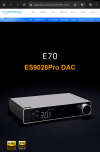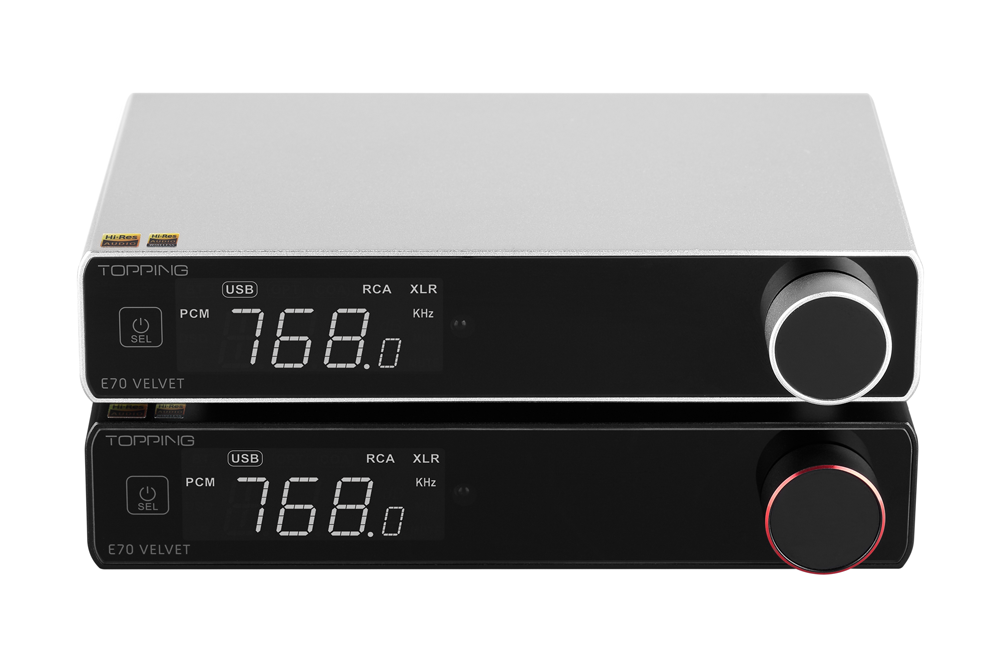Wondering if there will be a D90 velvet or a DX7+ velvet. But the D70V seems like a Great option at the moment.ppl just dyin to get one lol
-
WANTED: Happy members who like to discuss audio and other topics related to our interest. Desire to learn and share knowledge of science required. There are many reviews of audio hardware and expert members to help answer your questions. Click here to have your audio equipment measured for free!
- Forums
- Audio, Audio, Audio!
- DACs, Streamers, Servers, Players, Audio Interface
- Digital To Analog (DAC) Reviews and Discussion
You are using an out of date browser. It may not display this or other websites correctly.
You should upgrade or use an alternative browser.
You should upgrade or use an alternative browser.
Topping E70 Stereo DAC Review
- Thread starter amirm
- Start date
What is great on the V(elvet) we see a big hump in all new AKM implementations.Wondering if there will be a D90 velvet or a DX7+ velvet. But the D70V seems like a Great option at the moment.
Last edited:
As if that "big" hump is audibleWhat is great on the V(elvet) we see a big hump in all new AKM implementations.
not sure this is the right place to post this but it's the right device.
Trying Roon on a Windows box with the E70 connected via USB, and Roon sees the E70 as both WASAPI and ASIO options.
But only the ASIO option enables native DSD. The WASAPI option only offers PCM conversions. Is that expected behavior?
Trying Roon on a Windows box with the E70 connected via USB, and Roon sees the E70 as both WASAPI and ASIO options.
But only the ASIO option enables native DSD. The WASAPI option only offers PCM conversions. Is that expected behavior?
Veri
Master Contributor
- Joined
- Feb 6, 2018
- Messages
- 9,598
- Likes
- 12,040
If you really don't care about the aesthetics then no, there are plenty of good performers that are a bit cheaperIs there any advantage to spending $150 for the E70 over the SMSL DO100? My DO100 died and I’m wondering if the E70 has any real advantages over the SMSL? It would match my L70, but I don’t care about that aesthetic piece.
staticV3
Master Contributor
- Joined
- Aug 29, 2019
- Messages
- 8,007
- Likes
- 12,843
Yes. Native DSD isn't possible via WASAPI. Only DoP.But only the ASIO option enables native DSD. The WASAPI option only offers PCM conversions. Is that expected behavior?
For native DSD, ASIO is required.
777
Senior Member
- Joined
- Jan 1, 2019
- Messages
- 486
- Likes
- 360
Have you ever opened it before? How does the I/V converter under the tin box look like?Hi, measurement wise, the ESS seems a little better compared to the AKM. I have the ESS E70, I am really happy with it. Would not spend the 100 bucks more, see no reason.
The DO 100 is a relatively new DAC, how did it die?Is there any advantage to spending $150 for the E70 over the SMSL DO100? My DO100 died and I’m wondering if the E70 has any real advantages over the SMSL? It would match my L70, but I don’t care about that aesthetic piece.
wacomme
Senior Member
- Joined
- May 11, 2022
- Messages
- 428
- Likes
- 110
I have no idea. I returned home after 13 days in the hospital for two lumbar spine fusions, and while the controls all appear to work and function properly, I’m getting no sound through the dac. I’ve isolated the problem to the dac. Replacing the dac with a Qudelix everything works.The DO 100 is a relatively new DAC, how did it die?
No, I have it now for a few days and would not violate the European warranty regulations (2 years!) but I am also curious to see how Topping found the solution for the IMD hump. My speculation is described here.Have you ever opened it before? How does the I/V converter under the tin box look like?
From the thread:
ESS ES9039PRO and ES9027PRO announced
Yesterday it was a little late.... Today I need a little help to understand the ESS schematic.9039PRO and 9027PRO also have revised "recommended output stages" in their datasheets (https://www.esstech.com/products-overview/digital-to-analog-converters/sabre-audiophile-dacs/) which use a back-to-back de-glitch capacitor plus no "angst" resistor for the I/V capacitor (sounds familiar, doesn't it ;-). They also use a common-mode control loop with an extra opamp to force the output voltages to be exactly 0V rather than using a bias voltage directly.
The 9027PRO circuit shown in the datasheet looks, let's say, somewhat special... probably a drawing error...
Mostly we can see here some tweaks of the I/V stage, from KSTR already shown here February 2022.
The offset problem is here solved with an active stage. So far, so good. Now I was expecting a slow (integrating)
offset compensation. Here we can see something very fast acting (51 pF!!) integrating (compensating) capacitor and a fast OP -amp. Some Ideas?
Last edited:
Next to this issue mentioned here, I updated the E70 to firmware 1.04. The latter allows selecting DPLL bandwidth from 5 (default) to 15. I fixed my skipping issue, while playing thought LG OLEDC2's optical out, by using the 11 setting.
Here is the measured Jitter performance between setting 5, 9, 11 & 15:

Exemplarily clean.


...Starts to be quite ugly, but sidebands are still 120dB below the fundamental.

Completely messed-up. Avoid.


Againt USB:

Here is the measured Jitter performance between setting 5, 9, 11 & 15:
Exemplarily clean.
...Starts to be quite ugly, but sidebands are still 120dB below the fundamental.
Completely messed-up. Avoid.
For now, when Coax is good, it usually means Toslink will be just as good
For the record:Usually. Not always, as you know.
Againt USB:
Last edited:
KSTR
Major Contributor
This is not your typical LF/DC servo loop. Rather, this is a non-inverting composite fast full-frequency amp (and the 51pF is the RF-compensation for that composite) whose input signal is zero (GND on the +IN pin) and therefore the sum of the I/V output signals must be zero as well (within precision set by the mixing resistors) which is what we want -- make the signal symmetric with regard to output GND, at all times, dynamically. The actual I/V-stages are the closed loop slave amplifiers in that composite, running in parallelThe offset problem is here solved with an active stage. So far, so good. Now I was expecting a slow (integrating)
offset compensation. Here we can see something very fast acting (51 pF!!) integrating (compensating) capacitor and a fast OP -amp. Some Ideas?
Last edited:
If I see the tiny IV box Topping has now, they must have designed a highly integrated solution. Or could find a more effective (fewer components, cost-effective) solution. The massive paralleling OP -Amp I/V stages to reduce noise is not always without penalties. Two 8 Chanel DAC for stereo measure, sometimes not better than one for the job.This is not your typical LF/DC servo loop. Rather, this is a non-inverting composite fast full-frequency amp (and the 51pF is the RF-compensation for that composite) whose input signal is zero (GND on the +IN pin) and therefore the sum of the I/V output signals must be zero as well (within precision set by the mixing resistors) which is what we want -- make the signal symmetric with regard to output GND, at all times, dynamically. The actual I/V-stages are the closed loop slave amplifiers in that composite, running in parallel
Thanks to your explanation some time ago, I could understand the circuit. Until now, we see specially in SMSL-Circuits trim pots only for eliminating the DC- offset. To eliminate the common mode errors over the full frequency range without trimming makes it even better.This is not your typical LF/DC servo loop. Rather, this is a non-inverting composite fast full-frequency amp (and the 51pF is the RF-compensation for that composite) whose input signal is zero (GND on the +IN pin) and therefore the sum of the I/V output signals must be zero as well (within precision set by the mixing resistors) which is what we want -- make the signal symmetric with regard to output GND, at all times, dynamically. The actual I/V-stages are the closed loop slave amplifiers in that composite, running in parallel
staticV3
Master Contributor
- Joined
- Aug 29, 2019
- Messages
- 8,007
- Likes
- 12,843
Measurements of the E70 and E70VDo we have measurements of the AKM version?
Yeah probablyI assume this one uses the old 9028PRO's?

They were launched almost simultaneously. E70 first, then E70V like one or two weeks later.I'm a bit lost in their naming scheme, is the E70 "Velvet" with AKM a newer model or have they been launched alongside each other?
It's called "Velvet" because of AKM's "Velvet sound" slogan.
"Velvet" indicates that an AKM chip is used.
Veri
Master Contributor
- Joined
- Feb 6, 2018
- Messages
- 9,598
- Likes
- 12,040
Velvet is AKM's marketing to make consumers think products powered with their chips/solutions will sound more velvety/"analogue". No science to it. But people are gullible so I'm sure it works out for them..Do we have measurements of the AKM version? I assume this one uses the old 9028PRO's?
I'm a bit lost in their naming scheme, is the E70 "Velvet" with AKM a newer model or have they been launched alongside each other?
Gradius
Addicted to Fun and Learning
VERY expensive ($100 more):

 shenzhenaudio.com
shenzhenaudio.com

TOPPING E70V AK4191+AK4499EX Digital to Analog Convertor (DAC)
Spec: PCM USB IN:44.1kHz-768kHz/16bit-32bit COAX/OPT IN:44.1kHz-192kHz/16bit-24bit BT IN:AAC/SBC/APTX/APTX LL/APTX HD/APTX-Adaptive/LDAC DSD(Native) USB IN:DSD64-DSD512 COAX/OPT IN:can not support BT IN:can not support DSD(DoP) DSD64-DSD256 COAX/OPT IN:can not support BT IN:can not support E70 ...
Similar threads
- Replies
- 45
- Views
- 4K
- Replies
- 13
- Views
- 992
- Poll
- Replies
- 303
- Views
- 44K
- Replies
- 378
- Views
- 96K
